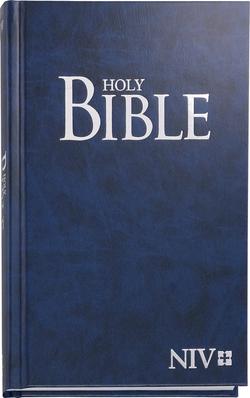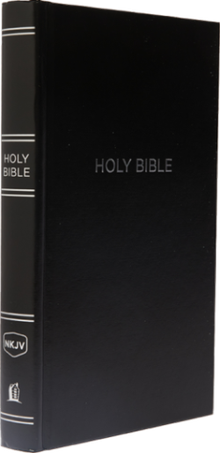
The New International Version (NIV) is a translation of the Bible into contemporary English. Published by Biblica, the complete NIV was released in 1978 with a minor revision in 1984 and a major revision in 2011. The NIV relies on recently-published critical editions of the original Hebrew, Aramaic, and Greek texts.
George Mamishisho Lamsa was an Assyrian author. He was born in Mar Bishu in what is now the extreme east of Turkey. A native Aramaic speaker, he translated the Aramaic Peshitta Old and New Testaments into English. He popularized the claim of the Assyrian Church of the East that the New Testament was written in Aramaic and then translated into Greek, contrary to academic consensus.

The Living Bible is a personal paraphrase, not a translation, of the Bible in English by Kenneth N. Taylor and first published in 1971. Taylor used the American Standard Version of 1901 as his base text.

Wycliffe's Bible or Wycliffite Bibles (WYC) are names given for a sequence of Middle English Bible translations believed to have been made under the direction or instigation of English theologian John Wycliffe of the University of Oxford. They represent the earliest known literal translations of the entire Bible into English. They appeared over a period from approximately 1382 to 1395.

The New King James Version (NKJV) is a translation of the Bible in contemporary English. Published by Thomas Nelson, the complete NKJV was released in 1982. With regard to its textual basis, the NKJV relies on a recently published critical edition for the Old Testament, while opting to use the Textus Receptus for the New Testament.

John 20:16 is the sixteenth verse in the twentieth chapter of the Gospel of John in the New Testament of the Bible. The verse describes the moment that Mary Magdalene realizes that Jesus has returned from the dead, when she recognizes his voice calling her name
The Amplified Bible (AMP) is an English language translation of the Bible produced jointly by Zondervan and The Lockman Foundation. The first edition as a complete volume was published in 1965. "Amplifications" are words or phrases intended to more fully bring out the meaning of the original text but distinguished from the translation itself by a unique system of brackets, parentheses, and italics. The translation is largely one of formal equivalence (word-for-word).
The Darby Bible refers to the Bible as translated from Hebrew and Greek by John Nelson Darby.

John 15 is the fifteenth chapter in the Gospel of John in the New Testament section of the Christian Bible. It is part of what New Testament scholars have called the 'farewell discourse' of Jesus. It has historically been a source of Christian teaching and Christological debate and reflection, and its images have been influential in Christian art and iconography. The chapter implies one of the highest and most developed Christologies to be found in the New Testament. The original text was written in Koine Greek. The book containing this chapter is anonymous, but early Christian tradition uniformly affirmed that John composed this Gospel.

Mark 4 is the fourth chapter of the Gospel of Mark in the New Testament of the Christian Bible. It tells the parable of the Sower, with its explanation, and the parable of the Mustard Seed. Both of these parables are paralleled in Matthew and Luke, but this chapter also has a parable unique to Mark, the Seed Growing Secretly. The chapter ends with Jesus calming the storm.

Mark 7 is the seventh chapter of the Gospel of Mark in the New Testament of the Christian Bible. It explores Jesus' relationships with both fellow Jews and Gentiles. Initially Jesus speaks with the Pharisees and scribes, and then with his disciples, about defilement. Later in the chapter Jesus heals two gentiles, one in the region of Tyre and Sidon and the other in the Decapolis region.
The Phillips New Testament in Modern English (Phi) is an English translation of the New Testament of the Bible translated by Anglican clergyman J. B. Phillips first published in 1958.
Matthew 16 is the sixteenth chapter in the Gospel of Matthew in the New Testament section of the Christian Bible. Jesus begins a journey to Jerusalem from the vicinity of Caesarea Philippi, near the southwestern base of Mount Hermon. Verse 24 speaks of his disciples "following him".

Matthew 19 is the nineteenth chapter in the Gospel of Matthew in the New Testament section of the Christian Bible. The book containing this chapter is anonymous, but early Christian tradition uniformly affirmed that Matthew composed this Gospel. Jesus commences his final journey to Jerusalem in this chapter, ministering through Perea. It can be seen as the starting point for the passion narrative.

Matthew 20 is the twentieth chapter in the Gospel of Matthew in the New Testament of the Christian Bible. Jesus continues his final journey through Perea and Jericho, heading towards Jerusalem, which he enters in the following chapter.

John 10 is the tenth chapter of the Gospel of John in the New Testament of the Christian Bible. The author of the book containing this chapter is anonymous, but early Christian tradition uniformly affirmed that John composed this Gospel. This chapter records Jesus' description of himself as the "door of the sheep" and the "Good Shepherd", and contains the only mention of Hanukkah, "the Feast of Dedication", in the New Testament.
Luke 20 is the twentieth chapter of the Gospel of Luke in the New Testament of the Christian Bible. It records the teaching of Jesus Christ in the temple in Jerusalem, especially his responses to questions raised by the Pharisees and Sadducees. The book containing this chapter is anonymous, but early Christian tradition uniformly affirmed that Luke the Evangelist composed this Gospel as well as the Acts of the Apostles.
The Holy Bible: Easy-to-Read Version (ERV) is an English translation of the Bible compiled by the World Bible Translation Center. It was originally published as the English Version for the Deaf (EVD) by BakerBooks.
The New Life Version (NLV) of the Bible is a simplified English translation by Gleason and Kathryn Ledyard.

Good News Bible (GNB), also called the Good News Translation (GNT) in the United States, is an English translation of the Bible by the American Bible Society. It was first published as the New Testament under the name Good News for Modern Man in 1966. It was anglicised into British English by the British and Foreign Bible Society with the use of metric measurements for the Commonwealth market. It was formerly known as Today's English Version (TEV), but in 2001 was renamed the Good News Translation in the U.S., because the American Bible Society wished to improve the GNB's image as a translation where it had a public perception as a paraphrase. Despite the official terminology, it is still often referred to as the Good News Bible in the United States. It is a multi-denominational translation, with editions used by many Christian denominations. It is published by HarperCollins, a subsidiary of News Corp.











